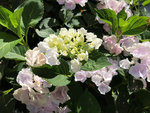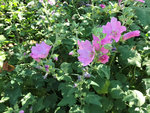

A walk in the neighborhood confirms that early August is the time when all our garden successes and shortcomings become obvious.
This year it’s also been a week of reckoning about which trees, shrubs, ferns, flowers and vegetables can tolerate hot sun, and which might even benefit from a big dose of it.
That’s too much territory to cover all at once, but here are just a few observations.
First, two reliably successful plants make summer even better, and did fine through the heat wave: Hydrangeas and crocosmia.
Hydrangeas galore
There are hydrangeas blooming everywhere you look right now – all of the four main varieties, in variations of blue, pink, mauve, and white. There are also some that bloom white and then turn pink or even red.
So if you would like a summer blooming shrub that’s reliable and easy to care for, you can “shop” by scoping out the ones you see when you’re out and about, and deciding which you like best.
There’s one I hope you won’t like: Some plant breeder created a new variety and named it an “Incrediball.” I have seen the Incrediballs and can attest that they are. They are billed as having flowers “almost as big as a basketball,” and that claim is true, but alas, the ones I saw did not have stems sturdy enough to hold all those basketballs up. Size does matter, and once again, bigger is not better.
Fortunately, there are countless others to choose from. Hydrangea fossils have been found in North America, so they’ve definitely been around for a long time. They are wonderful to have around this time of year when so many other flowers are already finished.
If you decide to plant one when the weather cools off – or if you have one you’re not sure when or how to prune – this website is the most helpful I’ve found. It also has clear explanations and photographs of the four varieties.
Lucifer crocosmia
The red Lucifer crocosmia is one of a small genus, also known as montbretia, that is sinfully easy to grow in most any sunny location. Before Lucifer became widespread, a smaller, orange variety of montbretia was more common and is still around in older plantings. All of the crocosmias grow into big clumps that need to be dug up and divided every few years.
Lucifer is the biggest and the reddest, but it is also the most likely to fall down and look hungover at the end of the season. This is especially true if it’s in rich soil that makes it grow extra big. The older, smaller, orange ones are less spectacular but age more gracefully. All need regular water.
Hummingbirds must be very happy that Lucifer crocosmia has become so popular. Hummers’ long narrow bills fit nicely in those tubular flowers, and there are lots of blossoms close together, which means fewer calories expended per sip of nectar.
There’s a clump of Lucifer crocosmia at a gas station on the corner of Plum and Union in Olympia – possibly the least scenic spot in town. That Lucifer always catches my eye just because it’s such an unexpected place to see flowers. I wonder, with all those lanes of traffic zipping by, if hummingbirds are bold enough to visit it.
And a report on the neighbors
Second, here are some ups and downs:
The many big clumps of white Shasta daisies in the neighborhood are mostly spent, and they look like they’ve been in a bar fight. About a month ago, a gardener told me she deadheads hers, and keeps them blooming all summer. She must be the only person who does.
There’s also a lovely patch of mallow up the street. (See photo with this story.) It’s a smaller, more delicate looking relative of hollyhocks. This is one of the many flowers that come back year after year when it’s allowed to go to seed. You just have to not mistake it for a weed and pull it in the spring. You can guess how I know this.
Sad to say, there are also a lot of butterfly bushes (aka Buddleia) that have bloomed and are now spreading their invasive seeds far and wide. These seeds sprout along rivers and disrupt riparian ecosystems that local critters depend on. The seeds can travel a long way. So unless you have one of the relatively new, seedless varieties, spent butterfly bush flowers should be cut and put in the garbage, preferably before they go to seed.
Jill Severn writes from her home in Olympia, where she grows vegetables, flowers and a small flock of chickens. She loves conversation among gardeners. Start one by emailing her at jill@theJOLTnews.com
1 comment on this item Please log in to comment by clicking here
Georgewalter
After the bloom is finished, Crocosmia stems with seed pods remain colorful and make a nice addition to a fall bouquet.
Saturday, August 6, 2022 Report this